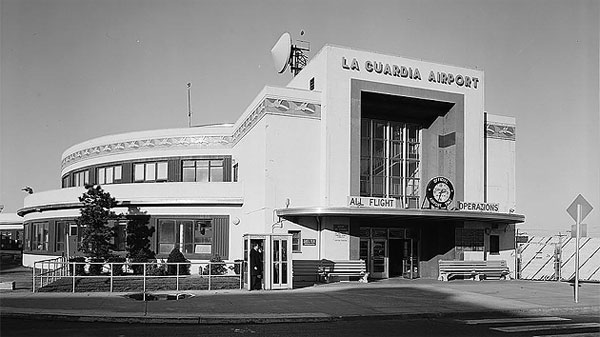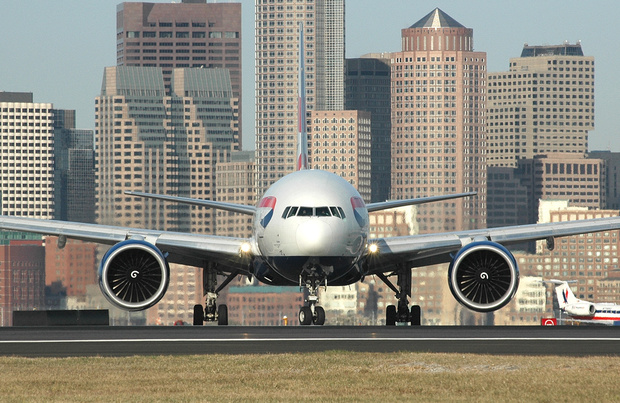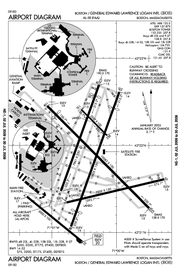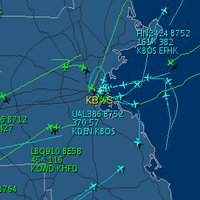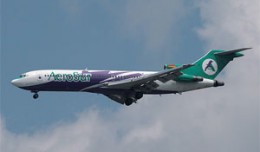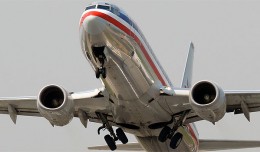| Airport use | Open to the public |
|---|---|
| Activation date | 04/1940 |
| Sectional chart | New York |
| Control tower | Yes |
| ARTCC | BOSTON CENTER |
| FSS | BRIDGEPORT FLIGHT SERVICE STATION |
| NOTAMs facility | BOS (NOTAM-D service available) |
| Attendance | Continuous |
| Wind indicator | Lighted |
| Segmented circle | No |
| Lights | Dusk-Dawn |
| Beacon | White-green (lighted land airport) |
| Landing fee | Yes |
| Fire and rescue | ARFF index E |
| International operations | Customs landing rights airport |
| See BOS Airport Radio Frequencies |
| Runway 15R/33L | |||||||||
|---|---|---|---|---|---|---|---|---|---|
| Dimensions | 10083 x 150 ft. / 3073 x 46 m | ||||||||
| Surface | asphalt/grooved, in good condition | ||||||||
| Weight bearing capacity |
|
||||||||
| Instrument approach | Runway 15R: ILS/DME | ||||||||
| Runway 33L: ILS/DME | |||||||||
| Runway 4R/22L | |||||||||
|---|---|---|---|---|---|---|---|---|---|
| Dimensions | 10005 x 150 ft. / 3050 x 46 m | ||||||||
| Surface | asphalt/grooved, in good condition | ||||||||
| Weight bearing capacity |
|
||||||||
| Runway edge lights | high intensity | ||||||||
| Instrument approach | Runway 4R: ILS/DME | ||||||||
| Runway 22L: ILS/DME | |||||||||
| Runway 4L/22R | |||||||||
|---|---|---|---|---|---|---|---|---|---|
| Dimensions | 7861 x 150 ft. / 2396 x 46 m | ||||||||
| Surface | asphalt/concrete/grooved, in good condition | ||||||||
| Weight bearing capacity |
|
||||||||
| Instrument approach | Runway 4L: VOR/DME | ||||||||
| Runway 22R: VOR/DME | |||||||||
| Runway 9/27 | |||||||||
|---|---|---|---|---|---|---|---|---|---|
| Dimensions | 7000 x 150 ft. / 2134 x 46 m | ||||||||
| Surface | asphalt/grooved, in good condition | ||||||||
| Weight bearing capacity |
|
||||||||
| Runway edge lights | high intensity | ||||||||
| Instrument approach | Runway 9: ILS/DME | ||||||||
| Runway 27: ILS/DME | |||||||||
| Runway 14/32 | |||||||||
|---|---|---|---|---|---|---|---|---|---|
| Dimensions | 5000 x 100 ft. / 1524 x 30 m | ||||||||
| Surface | asphalt/concrete/grooved, in good condition | ||||||||
| Weight bearing capacity |
|
||||||||
| Instrument approach | Runway 14: VOR/DME | ||||||||
| Runway 32: VOR/DME | |||||||||
| Runway 15L/33R | |||||||||
|---|---|---|---|---|---|---|---|---|---|
| Dimensions | 2557 x 100 ft. / 779 x 30 m | ||||||||
| Weight bearing capacity |
|
||||||||
| Instrument approach | Runway 15L: VOR/DME | ||||||||
| Runway 33R: VOR/DME | |||||||||
| Ownership | Publicly-owned |
|---|---|
| Owner | MASS PORT AUTHORITY ONE HARBORSIDE DR STE 200S BOSTON, MA 02128 Phone 617-428-2800 |
| Manager | EDWARD FRENI LOGAN INTERNATIONAL AIRPORT, ONE HARBORSIDE DR STE 200S EAST BOSTON, MA 02128-2909 Phone 617-567-5400 DEPT OF AVIATION. |
BOS Live Traffic |
BOS Sectional Chart |
| Originally called Boston Airport, Logan opened on September 8, 1923, and was used primarily by the Massachusetts Air Guard and the Army Air Corps. At that time, it was known as Jeffery Field. The first scheduled commercial passenger flights were initiated by Colonial Air Transport between Boston and New York City in 1927.The airport has expanded over the years, including the addition of 1,800 acres (730 ha) built on landfill in Boston Harbor and the incorporation of the former Governors and Apple Islands. As a consequence the airport is almost entirely surrounded by water. In 1952, the airport became the first in the United States with an indirect rapid transit connection. In 1956, the state renamed the airport as General Edward Lawrence Logan International Airport after a Spanish-American War officer from South Boston.The era of the jumbo jet began at Logan during the summer of 1970 when Pan Am inaugurated daily Boeing 747 service to London Heathrow Airport. Non-stop flights to London now are scheduled by British Airways, American Airlines, and Virgin Atlantic.When Terminal E opened in 1974, it was the second largest international arrivals facility in the United States. Since that time the number of international travelers using Logan has tripled. International long-haul travel has been the fastest growing market sector at Logan and has led the Massachusetts Port Authority (Massport) to embark on a major airport renewal project. The international terminal at Logan has been completely modified and upgraded into an elegant and impressive facility in recent years. Terminal E is a common-use facility, meaning all ticket counters and gates are shared among the international carriers.
Massport’s relationship with neighboring communities has been highly strained since the mid-1960s, when the agency took control of a significant parcel of residential land and popular fishing area adjacent to the northwest side of the airfield. This project was undertaken to extend Runway 15R/33L, which would later become Logan’s longest runway. Residents of the affected neighborhood, known as Wood Island, were bought out of their homes and forced to relocate. Public opposition came to a head when hordes of residents lay down in the streets in an attempt to block bulldozers and supply trucks from reaching the intended construction zone. A November 2006 issue of the Winthrop Transcript featured a front-page article about the operations of air traffic control at Logan. The article described the inside of the Logan tower as being approximately the size of a master bedroom and staffed by eight controllers. In one corner of the room, next to a coffee pot and Danish tray, were strategically-placed large bottles of antacids. Air Traffic Control for Logan Airport is handled at the Boston Consolidated TRACON facility in Merrimack, New Hampshire, which opened in 2004 and serves most of New England’s airspace. In March 2007, the Boston Herald revealed that Massachusetts State Police personnel were the beneficiaries of a hidden perk that authorized a $40 daily stipend for troopers who commuted to work using their own vehicles, despite a sufficient inventory of take-home cruisers. Although the policy, upon public disclosure, was immediately eliminated for troopers patrolling the Massachusetts Turnpike, sources claim that a similar perk still remains in place for troopers stationed at Logan. Massport has thus far refused to confirm or deny this.[6] Construction has been completed on an additional runway, 14-32. This runway was first proposed in 1973, but had been delayed by court action.[7] A scene from the 2006 film The Departed was filmed on location at Logan, inside the connector bridge between Terminal E and the Central Parking Garage. Terminal C and several United Airlines aircraft can be seen in the background. Parts of the recent Delta Air Lines 2007 “Anthem” commercial were filmed inside Terminal A as well as the connector bridge between Terminal A and Central Parking. On April 9, 2008, Massport announced that Grand China Airlines had formally applied to the Civil Aviation Administration of China for approval to operate daily non-stop passenger flights to Boston from Beijing using Boeing 787 aircraft. According to Massport, due to delays in production of the 787, the service is not likely to begin before 2010.[8] This is also consistent with government regulations on Chinese route approval, which has allocated all Chinese routes up through 2009. [9][10] Logan last had service to Asia in July 2001, when Korean Air discontinued service to Seoul, Korea, which operated with a stop in Washington, D.C
|
This page contains excerpts of Wikipedia entry Boston-Logan International Airport, shared under the GNU Free Documentation License. |


